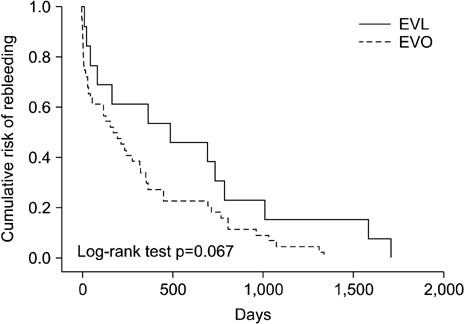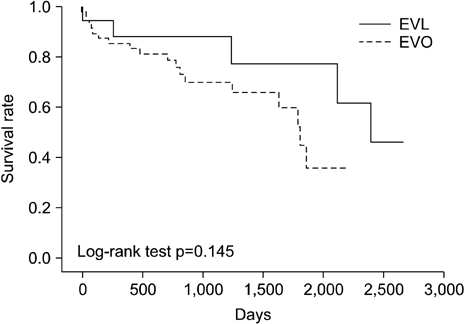Chonnam Med J.
2013 Apr;49(1):14-19. 10.4068/cmj.2013.49.1.14.
Comparison of Endoscopic Variceal Ligation and Endoscopic Variceal Obliteration in Patients with GOV1 Bleeding
- Affiliations
-
- 1Department of Internal Medicine, Chonnam National University Medical School, Gwangju, Korea. Choisk@jnu.ac.kr
- KMID: 2172171
- DOI: http://doi.org/10.4068/cmj.2013.49.1.14
Abstract
- The aim of this study was to compare the efficacy, rebleeding rates, survival, and complications of endoscopic variceal ligation (EVL) with those of endoscopic variceal obliteration (EVO) in patients with acute type 1 gastroesophageal variceal (GOV1) bleeding. Data were collected retrospectively at a single center. A total of 84 patients were selected (20 patients underwent EVL; 64 patients underwent EVO) from February 2004 to September 2011. Their clinical characteristics, laboratory results, vital signs, Child-Pugh score, Model for End-stage Liver Disease (MELD) score, and overall mortality were evaluated. There were no significant differences in baseline characteristics between the two groups. The success rate in initial control of active bleeding was not significantly different between the EVL and EVO groups (18/20 EVL, or 90.0%, compared with 62/64 EVO, or 96.9%; p=0.239). The early rebleeding rate was also not significantly different between the groups (3/18 EVL, or 16.7% compared with 17/62 EVO, or 27.4%; p=0.422). The late rebleeding rate of the EVL group was lower than that of the EVO group (3/18 EVL, or 16.7%, compared with 26/59 EVO, or 44.1%; p=0.042). The time-to-rebleeding was 594 days for the EVL group and 326 days for the EVO group (p=0.054). In the multivariate analysis, portal vein thrombosis (PVT) was a significant risk factor for early rebleeding. Hepatocellular carcinoma (HCC) and previous history of bleeding were significant risk factors for very late rebleeding. In conclusion, EVL is better than EVO in reducing late rebleeding in acute GOV1 bleeding. HCC, PVT, and previous bleeding history were significant risk factors for rebleeding.
MeSH Terms
Figure
Reference
-
1. Sarin SK, Lahoti D, Saxena SP, Murthy NS, Makwana UK. Prevalence, classification and natural history of gastric varices: a long-term follow-up study in 568 portal hypertension patients. Hepatology. 1992. 16:1343–1349.
Article2. Thakeb F, Salem SA, Abdallah M, el Batanouny M. Endoscopic diagnosis of gastric varices. Endoscopy. 1994. 26:287–291.
Article3. Watanabe K, Kimura K, Matsutani S, Ohto M, Okuda K. Portal hemodynamics in patients with gastric varices A study in 230 patients with esophageal and/or gastric varices using portal vein catheterization. Gastroenterology. 1988. 95:434–440.
Article4. Arakawa M, Masuzaki T, Okuda K. Pathomorphology of esophageal and gastric varices. Semin Liver Dis. 2002. 22:73–82.
Article5. Lo GH, Lai KH, Cheng JS, Chen MH, Chiang HT. A prospective, randomized trial of butyl cyanoacrylate injection versus band ligation in the management of bleeding gastric varices. Hepatology. 2001. 33:1060–1064.
Article6. Tan PC, Hou MC, Lin HC, Liu TT, Lee FY, Chang FY, et al. A randomized trial of endoscopic treatment of acute gastric variceal hemorrhage: N-butyl-2-cyanoacrylate injection versus band ligation. Hepatology. 2006. 43:690–697.
Article7. Suk KT, Baik SK, Yoon JH, Cheong JY, Paik YH, Lee CH, et al. Korean Association for the Study of the Liver. Revision and update on clinical practice guideline for liver cirrhosis. Korean J Hepatol. 2012. 18:1–21.
Article8. Peck-Radosavljevic M, Trauner M, Schreiber F; Austrian Society of Gastroenterology and Hepatology. Austrian consensus on the definition and treatment of portal hypertension and its complications. Endoscopy. 2005. 37:667–673.
Article9. Garcia-Tsao G, Sanyal AJ, Grace ND, Carey W. Practice Guidelines Committee of the American Association for the Study of Liver Diseases. Practice Parameters Committee of the American College of Gastroenterology. Prevention and management of gastroesophageal varices and variceal hemorrhage in cirrhosis. Hepatology. 2007. 46:922–938.
Article10. Qureshi W, Adler DG, Davila R, Egan J, Hirota W, Leighton J, et al. Standards of Practice Committee. ASGE Guideline: the role of endoscopy in the management of variceal hemorrhage, updated July 2005. Gastrointest Endosc. 2005. 62:651–655.
Article11. de Franchis R. Baveno V Faculty. Revising consensus in portal hypertension: report of the Baveno V consensus workshop on methodology of diagnosis and therapy in portal hypertension. J Hepatol. 2010. 53:762–768.
Article12. Ryan BM, Stockbrugger RW, Ryan JM. A pathophysiologic, gastroenterologic, and radiologic approach to the management of gastric varices. Gastroenterology. 2004. 126:1175–1189.
Article13. Sarin SK, Jain AK, Jain M, Gupta R. A randomized controlled trial of cyanoacrylate versus alcohol injection in patients with isolated fundic varices. Am J Gastroenterol. 2002. 97:1010–1015.
Article14. Beppu K, Inokuchi K, Koyanagi N, Nakayama S, Sakata H, Kitano S, et al. Prediction of variceal hemorrhage by esophageal endoscopy. Gastrointest Endosc. 1981. 27:213–218.
Article15. Ramond MJ, Valla D, Mosnier JF, Degott C, Bernuau J, Rueff B, et al. Successful endoscopic obturation of gastric varices with butyl cyanoacrylate. Hepatology. 1989. 10:488–493.
Article16. Hou MC, Lin HC, Kuo BI, Lee FY, Schmidt CM, Lee SD. Clinical implications of the white nipple sign and its role in the diagnosis of esophageal variceal hemorrhage. Am J Gastroenterol. 1996. 91:2103–2109.17. Jun CH, Park CH, Lee WS, Joo YE, Kim HS, Choi SK, et al. Antibiotic prophylaxis using third generation cephalosporins can reduce the risk of early rebleeding in the first acute gastroesophageal variceal hemorrhage: a prospective randomized study. J Korean Med Sci. 2006. 21:883–890.
Article18. Toubia N, Sanyal AJ. Portal hypertension and variceal hemorrhage. Med Clin North Am. 2008. 92:551–574.
Article19. Garcia-Pagán JC, Bosch J. Endoscopic band ligation in the treatment of portal hypertension. Nat Clin Pract Gastroenterol Hepatol. 2005. 2:526–535.
Article20. Mahadeva S, Bellamy MC, Kessel D, Davies MH, Millson CE. Cost-effectiveness of N-butyl-2-cyanoacrylate (histoacryl) glue injections versus transjugular intrahepatic portosystemic shunt in the management of acute gastric variceal bleeding. Am J Gastroenterol. 2003. 98:2688–2693.
Article21. Gallet B, Zemour G, Saudemont JP, Renard P, Hillion ML, Hiltgen M. Echocardiographic demonstration of intracardiac glue after endoscopic obturation of gastroesophageal varices. J Am Soc Echocardiogr. 1995. 8:759–761.
Article22. de Franchis R, Primignani M. Why do varices bleed? Gastroenterol Clin North Am. 1992. 21:85–101.
Article
- Full Text Links
- Actions
-
Cited
- CITED
-
- Close
- Share
- Similar articles
-
- Endoscopic Treatment and Prevention of Acute Variceal Hemorrhage
- The Use of Vasoconstrictors in Acute Variceal Bleeding: How Long Is Enough?
- Endoscopic Therapy and Radiologic Intervention of Acute Gastroesophageal Variceal Bleeding
- Removal of a Trigger Cord Stuck between Bands during Endoscopic Multiple-Band Ligation for Treating Esophageal Variceal Hemorrhage
- Comparison of Endoscopic Variceal Ligation versus Combined Ligation and Sclerotherapy for Bleeding Esophageal Varices



